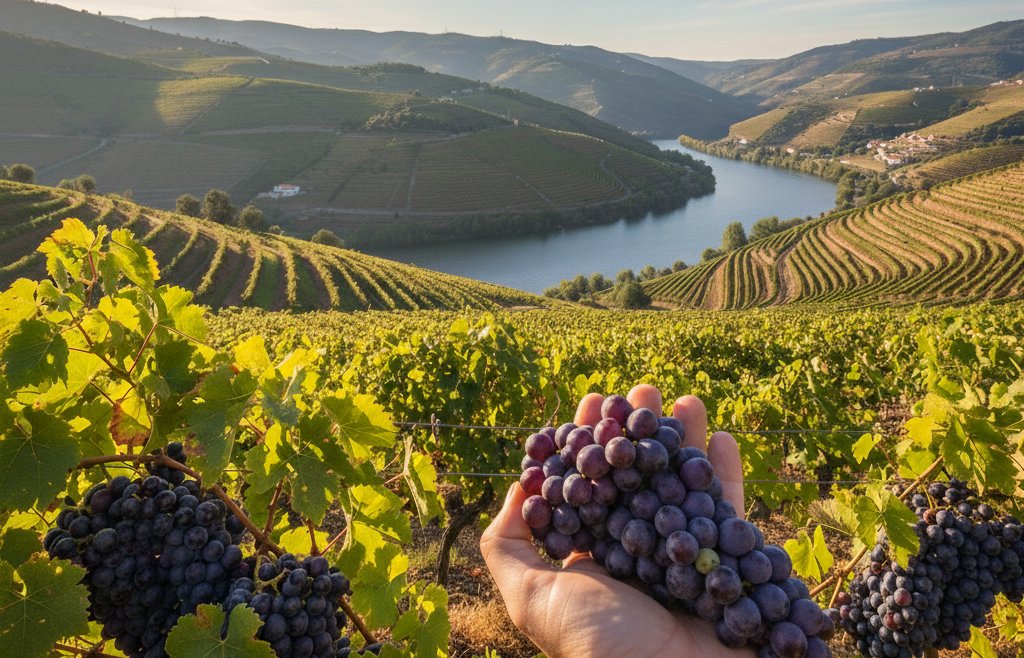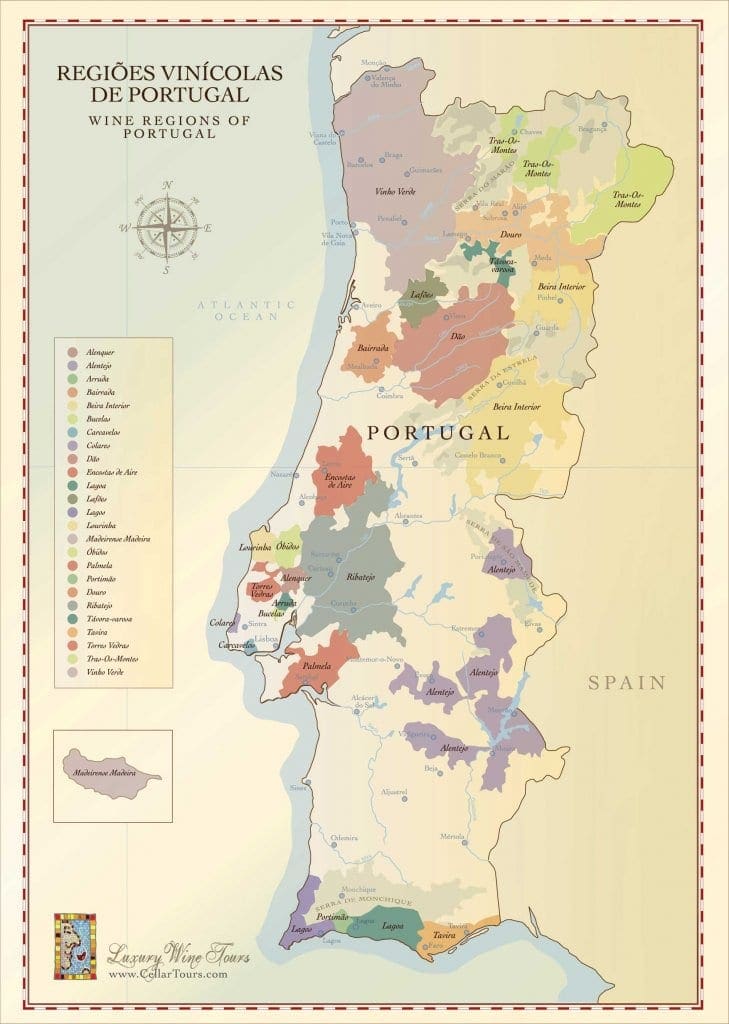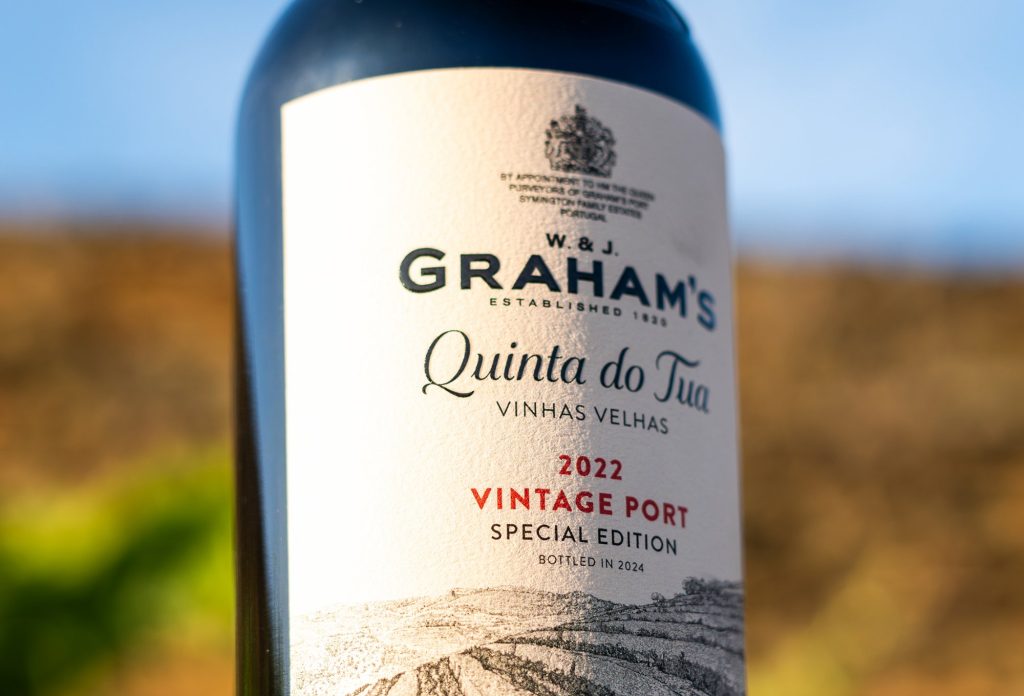
Portuguese Wine Labels Explained: A Complete Guide for Wine Lovers
August 14, 2025
Explore the world of Portuguese wine labels and learn how they reflect the vineyards' quality and unique grape varieties.
By: Barnaby Eales / Last updated: November 20, 2025
Portuguese wine producers have taken their art of blending several varieties to new levels, using diverse production and aging methods, whilst recovering and showcasing the potential of native grapes and learning more about soils. Portuguese wines are now made with greater precision, finesse, and elegance: there is less concentration and more refined extraction techniques. In parallel, there are better expressions of single-variety wines.
Portugal once operated in the shadows of its bigger EU neighbours, but its diverse still wines have stolen the limelight, away from the historical focus on Port and Madeira.

On Europe’s southern Atlantic edge, the seafaring nation of Portugal may be small geographically, but it punches well above its weight in terms of wine quality, diverse styles of production, and vinous heritage. It is understood that the Tartessians introduced vines to Portugal as early as 4,000 years ago.
After the Phoenicians and Greeks, the Romans extended plantations and production techniques further north, naming the region Lusitania. The Romans introduced amphorae, clay pots known in Portugal as Talhas, a method enjoying a revival beyond the heartlands of Vidigueira in Alentejo. Wine gained importance after the ‘Reconquista’ through monastic tradition.
Portugal is, of course, famed for its cork production, providing much of the world’s fine wines with stoppers, with cork traded in units called arrobas, a term derived from Arabic. Trade with England, Portugal’s oldest ally, from the 14th century onwards, brought international recognition to Portuguese wine and Port. EU membership in 1986 and the modernization of the appellation system, together with a new generation of resilient winemakers, have helped drive the captivating rise of contemporary Portuguese wine.
The Atlantic Ocean moderates Portugal’s largely hot Mediterranean and maritime climate. Portugal is home to diverse microclimates and soils, and dozens of wine sub-regions, from the lush, hilly green reaches of the Minho (Vinho Verde) and the magnificent heights of the Douro Valley and Trás-os-Montes to the spacious plains of Alentejo and its cork trees, the rugged granite terroirs of the Dão, the golden beaches of the Algarve, and the volcanic soils and waterfalls of the Azores archipelago and Madeira.

Many of Portugal’s vineyards historically were field blends of different varieties; the treasure of old vines persists in many regions. That said, given their characteristics, single-variety wines made from indigenous grapes are increasingly on trend. You’ll increasingly find single-varietal wines, including Alvarinho from Vinho Verde, Encruzado and Touriga Nacional from Dao, Baga from Bairrada, and Negra Mole from the Algarve. If indigenous grapes offer distinctive profiles, they also tend to be more disease-resistant in a changing climate than international varieties. Arinto grapes, for instance, with their higher-than-average acidity, help mitigate the impact of climate change on wine acidity.
Discover More About Portuguese Grapes
From the lighter, crisp white wines of Northern Portugal to the robust, earthy reds of Alentejo and the fortified wines of Douro and Madeira, the diverse range of Portuguese wine styles complements all types of dishes, from the rustic simplicity of sardines and cod plates to the colourful, contemporary new cuisine.
Pair regional wines with local foods: Atlantic seafood with coastal whites, inland meats with bolder reds, fortified wines with cheese, dessert, or as an aperitif. Yes, but further matches appear—such as Algarve fish with more acidic northern whites—especially as Portuguese cuisine evolves in modern menus and natural acidity in wines, which lowers the further south you go. Lighter dishes pair well with brighter whites and rosés; meanwhile, fine sparkling wines and Palhete wines are experiencing a resurgence. Portugal’s indigenous grapes, known for their flavor complexity, lend to consistent harmonisation.
Explore Our Guide to Portuguese Food and Wine Pairing
I always check the QR codes on the back label for more information about the producer and the wines. Although EU producers are only obliged to provide minimal information, some information on sugar levels and calories is available.
These QR codes sit alongside the traditional information printed on the label, especially the region and quality category. Portugal has 14 wine regions, with 31 DOCs and 12 Geographical Indications (IGs). DOC (Denominação de Origem Controlada, meaning Controlled Designation of Origin) is the highest quality level, known in the EU as PDO (Protected Designation of Origin).
Having DOC or PDO status means there are limits on the amount of wine that can be produced (yield limits), rules governing which approved grape varieties can be used, and oversight by regional wine commissions known as Comissões Vitivinícolas Regionais (CVRs). IGP or PGI (Protected Geographical Indication), and sometimes referred to as Vinho Regional (Regional Wine), designates wine produced within a specific region, but under more flexible regulations than DOC.
Read Our Guide to Understanding Portuguese Wine Labels

As well as showcasing its old wine culture, with foot-treading in lagares, for instance, and the role of single-estate quintas in shaping contemporary production, there are many colourful wine festivals to enjoy.
Looking out from Symington’s stylish and historic Quinta do Bomfim estate right on the water at Pinhão, at the boats and steep vineyards, is a view to cherish; Symington family’s Wine Varieties Library includes 31 different types of grapes grown across vineyards. It’s part of a project to understand and safeguard winemaking in the Douro’s beautiful mountainous terrain, a UNESCO World Heritage site.
Steeped in history dating back beyond the 17th century, Port, particularly Tawny Port, lives on despite the decline in volumes and the big shift in recent times towards the production of still wines and the rise of white wines. Port has adapted, with the focus moving beyond red to that of white and rosé ports. Pink Caipirinha, anyone? Made with Pink Port and Pink Caipirinha, known as CaipiPink, is the latest craze.
Grapes: Sousão, Touriga França, Touriga Nacional, Tinta Amarela, Tinta Barroca, Tinto Cão, Tinta Roriz (Tempranillo)
Discover More About the Douro Valley Wine Region
Walking inland through the estate of revered producer Julia Kemper Quinta do Cruzeiro, I could be in the land of Merlin: Big Granite boulders lie mysteriously and mystically strewn across the hilly wooded terrain. There is magic in the air. The feeling of otherworldliness extends to the finesse of Kemper’s organic and biodynamic wines. Once better known for its cooperatives, the Dão is one of Portugal’s in-vogue regions, with top fine wine producers like Taboadella and Textura Wines located in the foothills of Portugal’s most famous mountain range, the Serra da Estrela, championing the local grapes of Touriga Nacional and Encruzado, with the production of exquisite wines full of verve and energy and finesse.
Grapes: Baga, Bastardo, Mencía, Touriga Nacional, Tinta Roriz (Tempranillo)
Discover More About the Dão Wine Region
Travelling through the spacious and vast protected plains of Alentejo (Beyond the Tejo River), it was as if time stood still. There are more cork trees than people in Alentejo, the region that supplies around half the world’s cork supply. Tasting fine Burgundian-style white wine made from Arinto at Tapada de Coelheiros estate near Evora, I get a sense of an estate that runs in harmony with nature, with its biodiversity, sheep, bats, and walnut trees. Coelheiros is known for its sustainability measures, such as using diverse cover crops to dramatically lower soil temperatures by 20 degrees in the vineyards.
Alentejo is also home to one of Portugal’s best-known producers, Antonio Macanita, and many surprises, not least its ancient Talha (Amphora) wines made by the XXVI Talhas project at Adega do Mestre Daniel, and fine wines with pronounced acidity made from elevated sub-regions like Portalegre.
Pêra-Manca, a wine icon recovered from oblivion in 1990, is said to have been Portugal’s most famous still wine prior to phylloxera in the 19th century, which decimated original vineyards and led to the loss of the name. Then Adega Cartuxa surprised the markets on Halloween 2025 by announcing the release of the Pêra-Manca tinto 2019.
Pedro Baptista, winemaker at Adega Cartuxa, said:
‘A climatically balanced year favoured grapes’ ripeness, with the wine’s density, elegance, and wonderful freshness aligned perfectly thanks to exemplary Trincadeira and Aragonez (aka Tempranillo) grapes.’
Grapes: Alicante Bouschet, Cabernet Sauvignon, Petit Verdot, Syrah, Touriga Nacional , Tinta Roriz (Tempranillo), Touriga Franca, Trincadeira (Tinta Amarela)
Discover More About the Alentejo Wine Region
Not green wine, but increasingly premium wine. Often mistakenly translated as ‘green wine,’ Vinho Verde is a wine region (the ‘green’ refers to youthful wine), but much of that is changing as premiumisation increases. With demand growing for lighter yet fresh, elegant, and expressive wines, producers are making naturally balanced wines from lower yields of Alvarinho, Avesso, and Loureiro. Vinho Verde producers, including Aphros, Sem Igual, Casa da Paços, Quinta da Santa Teresa, and Quinta da Lixa, have transformed the region with the production of premium white wines and pet-nats.
Very much the in-vogue region, the big boys from the Douro have invested in the Alvarinho heartland of Vinho Verde’s sub-region Monçao e Melgaço. Having acquired Quinta do Hospital estate in 2017, Falua, owned by the Roullier Group, doubled Alvarinho plantings to 20ha. Since 2022, Symington’s and The Fladgate partnership from the Douro have also acquired historic MM estates. In May 2023, Anselmo Mendes, another leading Alvarinho winemaker, secured a joint venture to produce Alvarinho with Symington Family Estates.
Meanwhile, Vinho Verde’s biggest producer, Aveleda, has since 2018 invested close to €7m in 85ha of Alvarinho-led plantings on schist soils in a new vineyard located in Cabração, north of Ponte de Lima.
Grapes: Alvarinho (Albariño), Arinto, Loureiro, Trajadura
Discover More About the Vinho Verde (Minho) Wine Region
Setúbal Peninsula: Known for its soft red made from Castelão and fortified wines, producers also make fruity, sun-kissed rosés.
Tejo: value-driven, versatile rosés made near Lisboa, showing that Portugal’s wine revolution is spreading across the country.
Algarve: Together with the revival of the indigenous light grape variety Negra Mole, an increasing number of ‘swimming pool’ rosés are being made, mainly targeting tourists, alongside more structured wines with a saline edge.
There’s something of a quiet sparkling wine revolution going on in Portugal’s sparkling wine heartlands of Bairrada and Távora-Varosa, with producers attracting investment and further driving a rise in quality. In 2024, Caves da Murganheira, home to extensive underground tunnels carved from blue granite, released a range of vintage espumante wines sealed with Amorim corks. Portugal has never made enough volumes of sparkling wine for its fizz to be widely known, but that’s changing.
Learn More About Portuguese Sparkling Wine in our blog post
Bairrada: Home to the sought-after old vines of Baga used for age-worthy tannic reds and sparkling wine grown on limestone soils, Bairrada has become one of the key regions of the Portuguese wine renewal. The town of Anadia is known as the capital of sparkling wine in Bairrada, home to the Bairrada wine station and museum. Anadia’s winemakers are making structured whites, especially Bical.
Grapes: Bical, Cercial, Maria Gomes (Fernão Pires)
Discover more about the Bairrada Wine Region

Other than sweetness levels, styles are usually determined by whether the aging is in bottle or oak barrels. The key styles are Ruby (bright, younger ports), Tawny (a blend of ports from different vintages, aged longer), and Vintage (from a single year, aged in barrels and then further aged in bottle). Style categories are labelled on bottles.
Read Guide to Port Wine: History, Styles and Modern Trends
Madeira (made using local grape varieties), grown on the volcanic island, known for its pronounced acidity and quasi-indestructibility. A pivotal moment in Madeira’s rise was the Staple Act of 1663. Following the marriage of Charles II to Portugal’s Catherine of Braganza, the act exempted Madeira from the ban on exporting goods to English colonies unless shipped directly from English ports in English vessels.
Discover More About Moscatel and Fortified Wines of Portugal
Many of these top wines are included in VIP private visits with Cellar Tours, giving our guests the chance to experience the very pinnacle of Portuguese winemaking. However, narrowing down the country’s icons to a short list is no easy task.
2017 Niepoort Vintage Port
In the Douro, the acclaimed 2017 vintage has been widely compared to the triumphant 1945 vintage, with producers making some of the best ever ports. Both years featured advanced growing cycles, low rainfall, and a hot summer, resulting in early harvests. Yields were low, but quality was high. Historically, the most highly esteemed and expensive ports are vintage ports, blended and bottled after several years of ageing in wooden barrels. Ageing continues in bottles for usually several decades.
The Port houses and the IVDP, the Douro wine board, ‘declare’ such ports as vintage only in exceptional harvests after weighing in quality, quantity, and market factors, in the second year after production – the first declared vintage was 1775. Declaring consecutive vintages is rare, but this occurred in 2017 following the 2016 vintage. 2017 Niepoort is made from a field blend of 80-year-old vines, with each component described as harmonious as a symphony orchestra. Critics also championed several of the Symington Family’s 2017 vintage ports, such as Graham’s The Stone Terraces Vintage Port 2017.
Malmsey Madeira wines are known to be among the most resilient in the world, with sweetness balanced by typical high levels of acidity, and gaining richness and concentration with time in barrel. Bottled in 1975, this Malmsey has consistently won applause from pundits and experts who waxed lyrical about its power, complexity, and finesse, with pungent aromatic notes of marmalade, figs, and raisins. Noel Cossart, who managed producer Cossart Gordon, who penned Noël Cossart’s Madeira, The Island Vineyard, is known to have compared the 1954 vintage with the greatest Malmsey vintages of 1880 and 1808.
Casa Ferreirinha’s winemaker, Luis Sottomayor, has attributed the ageing potential of the Barca Velha 2015 to the mixture of hot and cold weather during that year, stating that 2015 will outlive the prized 1982 and 1999 vintages. The ‘strong structure echoes the grandeur of Barca-Velha 2011, and its vibrant acidity and elegance evoke the distinctive character of Barca-Velha 2008.’
Released in June 2024, Barca Velha 2015 aged in fine-grained French oak barrels for 18 months and aged for eight years after the vintage, reflects a changing climate: the 2015 Barca Velha is made up predominantly of the Portuguese grapes, Touriga Franca and Touriga Nacional and includes, for the time being, the Sousão, a grape variety used to add freshness to the wine.
Upon the wine’s release, Sottomayor said Tinta Roriz (aka Tempranillo), which traditionally dominated Barca Velha wines in former vintages, suffers more from hydric stress in the Douro than the other grapes. Barca Velha, known for its notes of liquorice and anise, became the first fine Douro still wine in 1952, thanks to the avant-garde efforts of Douro winemaker Fernando Nicolau de Almeida. Released only in exceptional vintages, Barca Velha has been produced in only 21 vintages.
Parcela Única 2021 Anselmo Mendes Vinho Verde Alvarinho
Known as Mr Alvarinho, Anselmo Mendes has been at the forefront of bringing the best out of old Alvarinho white wine grapes grown in their heartland of Monção e Melgaço, a vital sub-region of Vinho Verde, which has attracted significant investment in recent years. Burgundian in conception and in style, the barrel-fermented Parcela Unica is made only during the best year, from a single plot of vines. Lower in alcohol and less round than the 2018 vintage, a warmer year, the silky and complex Parcela Unica 2021 has the tautness and tension required for Alvarinho wines with adequate levels of bright acidity – a wine that will endure.
Pêra-Manca Tinto 2005
This wine icon, produced only in certain years, was revived from oblivion in 1990 and is said to have been Portugal’s most famous still wine prior to phylloxera in the 19th century, which decimated original vineyards. Adega Cartuxa surprised the markets in 2025 when it announced the release of the Pêra-Manca tinto 2019. A climatically balanced year favoured adequate maturity grapes, with the wine’s “density, elegance and wonderful freshness aligned perfectly thanks to exemplary Trincadeira and Aragonez (aka Tempranillo) grapes,” said Pedro Baptista, winemaker at Adega Cartuxa. One of the most prized recent vintages of the big, full-bodied wine is the 2005 vintage, known for its dark chocolate,
spice, and cherry flavours.
Back in 2005, Amorim, a major cork supplier and owner of wineries, opened Portugal’s first wine hotel at its Douro heritage estate, Quinta Nova de Nossa Senhora do Carmo. Since then, Portugal has gone big on wine tourism, developing capacity, routes, and features that encompass local culture, history, and education, as well as tailored, exclusive, high-end options in exquisite locations.
Wine tourism is a cornerstone of strategy, alongside tourism more broadly and exports, as the key to Portugal’s sensational economic rebound following the financial crash. Portuguese producers are stepping up their game, embracing sustainability. The Alentejo sustainability case study (See the e-book ‘Into The Heat’), a fine example (and one devoid of greenwashing), is based on organic practices and low-intervention winemaking. Not long ago, such wines were harder to find, but that’s changing, as is the level of winemaking, with more refined, elegant wines made with less concentration and more gentle extraction techniques, and essentially wines made to showcase the best of Portugal’s native grape varieties.
Portugal’s appeal is vast, with its wines, wine tourism innovation, and lifestyle on Europe’s southern Atlantic edge. Portugal is the place to return to, a reference point, whose weight in history, matched with its newfound protagonism in the world of wine, contrasts beautifully with the quiet reserve and unassuming allure of its people.
If you would like us to customize an exclusive luxury tour, contact us and let us know your travel plans. We offer luxury food and wine tours for private groups of a minimum two guests. In addition, all of our private, chauffeured tours are available year-round upon request.

